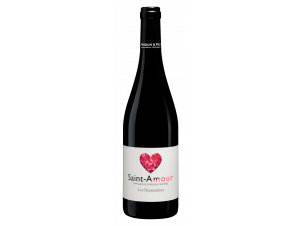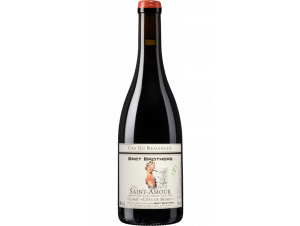You have no items in your shopping cart.
Wine Saint-Amour
At the northern end of the Beaujolais region, close to Mâcon, the vineyard associated with the village of Saint Amour produces a wine with an enchanting name. The wine is red and dry, it can be drunk young or after two or three years of ageing, and inevitably delights the palate with its fruity aromas. Read more on Saint-Amour
-
Top Selling
-
Top Selling
-
Top Selling
- -27%
- -30%
Appellation Saint-Amour
The Saint-Amour vineyard has a double Roman origin
It was the Romans who created the foundations of our vineyard, as they used to plant vines in all the territories they conquered. This is the case in the Beaujolais, but Saint Amour also takes its name from a Roman. Amor, was a Roman legionary, companion of Saint Maurice, the leader of the Theban legion. In 286, during a battle in the region of Thebes (today Luxor in Egypt), Amor refused to fight against the Christians. Escaping the massacre, he took refuge in Gaul where he became a missionary. This is how he bequeathed his name, Saint Amour, to the village which pays homage to him with his statue erected not far from the church.
As far as the vineyards are concerned, we owe it to the monks to keep them going from the 7th century onwards, following the retreat of the Romans. At that time, the Beaujolais region was part of the Duchy of Burgundy. The name of the region comes from the small town of Beaujeu, nestled in the west of the territory. In the 14th century, the Duke of Burgundy, Philippe le Hardi, banished the Gamay grape from the northern part of Burgundy. It found refuge in the Beaujolais region, where it instantly appreciated the soil.
The crop continued to develop over the centuries. The tradition of drinking the wines in their early youth is established. It allows to better take advantage of their deliciously fruity character and will then give birth to the Beaujolais Nouveau. The Saint Amour vineyard is located in Saône-et-Loire, south-west of Mâcon. It is located on the eastern slopes of the Mont de Bessay and the Colline de l'Église, and slopes gently down to the Saône plain. It extends over 325 hectares of primary crystalline soil and produces more than 16,000 hectolitres of high quality red wine annually.
Saint Amour has been recognised by the Institut National de l'Origine et de la Qualité (INAO) as an AOC since the decree of 8 February 1946. It also has the European label AOP (Appellation d'Origine Protégée), as well as the mention "cru". The latter is a distinctive sign of quality within a vineyard, as much for the terroir and climate as for the vinification and final tasting.
Gamay is the king grape variety of AOC Saint-Amour
Saint Amour benefits from a semi-continental climate with oceanic and Mediterranean influences. Its soils are granitic, clayey and sandy. Like all Beaujolais, Saint-Amour is made from Gamay noir with white juice. This is its main grape variety, but three other grape varieties are authorised as accessories, limited to 15%: aligoté, chardonnay and melon.
The colour of Saint Amour is a deep ruby with purple highlights. The nose offers peach and apricot aromas that mingle with small red fruits such as blackcurrant and raspberry. If you taste it after two or three years of ageing, its structure becomes more robust. It becomes more spicy and expresses notes of kirsch. As for its colour, as it ages, it changes from purple to deep garnet.
Poor in tannins, Saint Amour reveals a good acidity. Its fruity character does not prevent it from expressing more complexity if it is vinified using the traditional method with a toasted cap. This involves keeping the grapes in the juice by means of a grid, in order to obtain a better extraction of the colour and tannins.
The particularity of Gamay allows each terroir to express specific aromatic profiles. Each winemaker also puts his own stamp on the wine, drawing on the experience of his ancestors who have worked this terroir for centuries. The short vatting time of Saint Amour - about ten days - gives rise to tender wines, both fruity and floral, which can be drunk within eighteen months of the harvest. With longer maceration, the wines appear more solid and slightly rougher. You can keep them for three or four years, and even a few more.
The red wine of Saint Amour is best served with game birds. It is a wonderful accompaniment to quail in port, but also enjoys pork in all its forms: cold buffet with a plate of charcuterie, barbecued pork filet mignon, or pork cheek stew.
Perfect with cheese, you can also serve it with an omelette with chanterelles or an omette with ceps. If you are romantic, you won't have a Valentine's Day without a bottle of Saint Amour. And you can of course think of this wonderful Beaujolais for your wedding.
Saint-Amour domains to discover
Château de Beauregard
The Burrier family, present for more than 500 years in the vineyards of southern Burgundy, has owned Château de Beauregard for 6 generations.The vines are cultivated with respect for the environment, in order to favour the quality of the soil and the roots. The work of the soil and the quality of the grapes, followed by slow and natural vinification, in vats or in oak barrels, allow us to obtain the right expression of the Saint Amour terroir, with wines of the highest quality.
Domaine de la Pirolette
The Domaine de la Pirolette is perched at the top of the hill, facing the church of Saint Amour. The characterful building dates back to 1600 and is named after a pretty white flower: la Pirole. It is one of the largest estates in Saint-Amour, located on the best terroirs of the appellation.The owners of Château de la Pirolette, Grégory and Virginie Barbet, use the ancestral technique of the "chapeau grillé". This gentle extraction adds structure while preserving the elegance of the terroir. It creates elegant wines, full of freshness, energy and minerality.
Beaujolais et Lyonnais appellations





























 TWIL - Achat de Vin
TWIL - Achat de Vin


